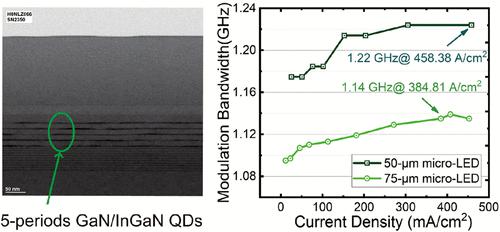当前位置:
X-MOL 学术
›
ACS Photonics
›
论文详情
Our official English website, www.x-mol.net, welcomes your
feedback! (Note: you will need to create a separate account there.)
Multigigabit Visible Light Communication Based on High-Bandwidth InGaN Quantum Dot Green Micro-LED
ACS Photonics ( IF 6.5 ) Pub Date : 2022-06-22 , DOI: 10.1021/acsphotonics.2c00380 Zixian Wei, Lei Wang, Zhongxu Liu, Chao Zhang, Chien-Ju Chen, Meng-Chyi Wu, Yanfu Yang, Changyuan Yu, Lai Wang, H.Y. Fu
ACS Photonics ( IF 6.5 ) Pub Date : 2022-06-22 , DOI: 10.1021/acsphotonics.2c00380 Zixian Wei, Lei Wang, Zhongxu Liu, Chao Zhang, Chien-Ju Chen, Meng-Chyi Wu, Yanfu Yang, Changyuan Yu, Lai Wang, H.Y. Fu

|
Long-wavelength light-emitting diode (LED) devices in the visible band (>492 nm) and their applications in high-speed visible light communication (VLC) have attracted tremendous research interest recently. The electrical-to-optical (E-O) bandwidth of conventional c-plane long-wavelength LEDs is limited by carrier lifetime in InGaN quantum well (QW), which is a fundamental problem limiting the data rate of high-speed VLC systems. In order to achieve an over GHz E-O bandwidth for applicable packaged LEDs, it is necessary to innovate from the material level in the active region. This work aims to break through the modulation bandwidth bottleneck of VLC systems based on green micro-LED. Commercial LEDs suffer a very limited E-O bandwidth due to their long radiative recombination carrier lifetime and large resistance-capacitance delay. Herein, by the utilization of green InGaN quantum dots (QDs) as the active region of micro-LED, this constraint can be remarkably alleviated. Green micro-LEDs containing five layers of InGaN QDs are fabricated, packaged, and then applied in a line-of-sight (LOS) VLC system over a 2 m free-space channel. The VLC system based on a single-pixel 50 and 75-μm diameter green micro-LEDs can achieve high modulation bandwidths up to 1.22 and 1.14 GHz, respectively. Then, real-time non-return-to-zero on–off keying (NRZ-OOK) and offline pulse-amplitude modulation four-level (PAM-4) as two common schemes in short-distance optical communication are adopted to evaluate the VLC system performances. A real-time 2.1 Gbps NRZ-OOK and an offline 5 Gbps PAM-4 VLC links are achieved with BERs of 2.74 × 10–3 and 1.88 × 10–3 above the forward error correction (FEC) criterion of 3.8 × 10–3, respectively. To the best of our knowledge, this is the highest-recorded modulation bandwidth and communication rate for a single-pixel green micro-LED-based VLC system.
中文翻译:

基于高带宽InGaN量子点绿光Micro-LED的多千兆可见光通信
可见波段(>492 nm)的长波长发光二极管(LED)器件及其在高速可见光通信(VLC)中的应用最近引起了极大的研究兴趣。传统c的电光 (EO) 带宽平面长波长 LED 受限于 InGaN 量子阱 (QW) 中的载流子寿命,这是限制高速 VLC 系统数据速率的基本问题。为了使适用的封装 LED 实现超过 GHz 的 EO 带宽,有必要从有源区的材料层面进行创新。本工作旨在突破基于绿色 micro-LED 的 VLC 系统调制带宽瓶颈。商用 LED 的 EO 带宽非常有限,因为它们具有较长的辐射复合载流子寿命和较大的电阻-电容延迟。在此,通过利用绿色 InGaN 量子点 (QD) 作为 micro-LED 的有源区,可以显着缓解这一限制。包含五层 InGaN QD 的绿色 micro-LED 被制造、封装、然后在 2 m 自由空间信道上应用于视距 (LOS) VLC 系统。基于单像素 50 和 75 微米直径的绿色微型 LED 的 VLC 系统可以分别实现高达 1.22 和 1.14 GHz 的高调制带宽。然后,采用实时不归零开关键控(NRZ-OOK)和离线脉冲幅度调制四电平(PAM-4)作为短距离光通信中的两种常见方案来评估VLC 系统性能。实时 2.1 Gbps NRZ-OOK 和离线 5 Gbps PAM-4 VLC 链路以 2.74 × 10 BER 实现 采用实时不归零开关键控(NRZ-OOK)和离线脉冲幅度调制四电平(PAM-4)作为短距离光通信中的两种常见方案来评估VLC系统表演。实时 2.1 Gbps NRZ-OOK 和离线 5 Gbps PAM-4 VLC 链路以 2.74 × 10 BER 实现 采用实时不归零开关键控(NRZ-OOK)和离线脉冲幅度调制四电平(PAM-4)作为短距离光通信中的两种常见方案来评估VLC系统表演。实时 2.1 Gbps NRZ-OOK 和离线 5 Gbps PAM-4 VLC 链路以 2.74 × 10 BER 实现–3和 1.88 × 10 –3分别高于前向纠错 (FEC) 标准 3.8 × 10 –3。据我们所知,这是基于单像素绿色 micro-LED 的 VLC 系统记录的最高调制带宽和通信速率。
更新日期:2022-06-22
中文翻译:

基于高带宽InGaN量子点绿光Micro-LED的多千兆可见光通信
可见波段(>492 nm)的长波长发光二极管(LED)器件及其在高速可见光通信(VLC)中的应用最近引起了极大的研究兴趣。传统c的电光 (EO) 带宽平面长波长 LED 受限于 InGaN 量子阱 (QW) 中的载流子寿命,这是限制高速 VLC 系统数据速率的基本问题。为了使适用的封装 LED 实现超过 GHz 的 EO 带宽,有必要从有源区的材料层面进行创新。本工作旨在突破基于绿色 micro-LED 的 VLC 系统调制带宽瓶颈。商用 LED 的 EO 带宽非常有限,因为它们具有较长的辐射复合载流子寿命和较大的电阻-电容延迟。在此,通过利用绿色 InGaN 量子点 (QD) 作为 micro-LED 的有源区,可以显着缓解这一限制。包含五层 InGaN QD 的绿色 micro-LED 被制造、封装、然后在 2 m 自由空间信道上应用于视距 (LOS) VLC 系统。基于单像素 50 和 75 微米直径的绿色微型 LED 的 VLC 系统可以分别实现高达 1.22 和 1.14 GHz 的高调制带宽。然后,采用实时不归零开关键控(NRZ-OOK)和离线脉冲幅度调制四电平(PAM-4)作为短距离光通信中的两种常见方案来评估VLC 系统性能。实时 2.1 Gbps NRZ-OOK 和离线 5 Gbps PAM-4 VLC 链路以 2.74 × 10 BER 实现 采用实时不归零开关键控(NRZ-OOK)和离线脉冲幅度调制四电平(PAM-4)作为短距离光通信中的两种常见方案来评估VLC系统表演。实时 2.1 Gbps NRZ-OOK 和离线 5 Gbps PAM-4 VLC 链路以 2.74 × 10 BER 实现 采用实时不归零开关键控(NRZ-OOK)和离线脉冲幅度调制四电平(PAM-4)作为短距离光通信中的两种常见方案来评估VLC系统表演。实时 2.1 Gbps NRZ-OOK 和离线 5 Gbps PAM-4 VLC 链路以 2.74 × 10 BER 实现–3和 1.88 × 10 –3分别高于前向纠错 (FEC) 标准 3.8 × 10 –3。据我们所知,这是基于单像素绿色 micro-LED 的 VLC 系统记录的最高调制带宽和通信速率。











































 京公网安备 11010802027423号
京公网安备 11010802027423号